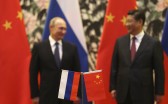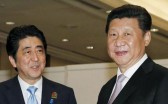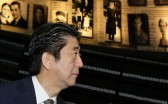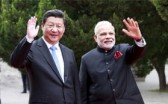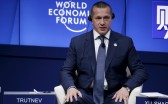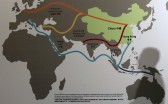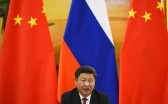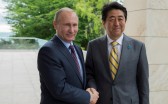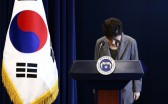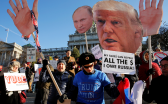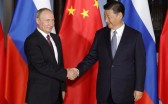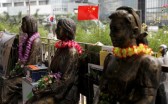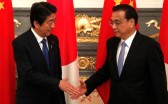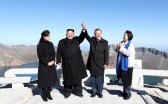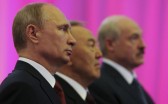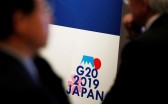Below I respond to the negative scenario for Sino-Russian relations, as presented by Brian Carlson, and attempt to discern the most realistic outcome for how this relationship will evolve in the short-term. The main argument is that the Chinese adage of “hot politics, cold economics” will continue to apply to Sino-Russian partnership, as bilateral trade may remain moribund while cooperation in geopolitics will continue to increase.
Bilateral Economic Ties are Weak. So What?
There is no question that, as Carlson mentions, the recent drop in overall bilateral trade is a sore point in the Sino-Russian relationship. However, as Paul Krugman pointed out in his recent article, Russia is largely a “petrostate” with two-thirds of its exports consisting of mineral oils, mineral fuels, and products of their distillation (second place is occupied by timber and wood-related products).1 Thus, it is virtually impossible for the overall Sino-Russian trade to rebound as long as the price of oil continues to fluctuate between $40 and $50 per barrel. However, despite low prices, Russia is selling more oil to China than ever.2 Moreover, Russia has begun to allow China to invest in “upstream” methods of production as evidenced by the deal between Rosneft and Beijing Enterprises Group Company Limited, announced during Vladimir Putin’s visit to Beijing in June, for a potential sale of a 20% stake in Rosneft’s oil producing subsidiary, Verkhnechonskneftegaz, to a unit of Beijing Gas Group.3
Progress is also being made on the construction of the “Power of Siberia” gas pipeline. Russia’s energy giant Gazprom and the China National Petroleum Corporation (CNPC) recently signed an engineering, procurement, and construction contract to build a crossing of the Power of Siberia pipeline under the Amur river.4 The pipeline is expected to be completed by the end of 2018. It is, therefore, important to view the drop in the price of oil as the primary culprit for the seeming stagnation of trade between Russia and China.
Furthermore, Sino-Russian bilateral trade is becoming more diversified as Russia is importing a wider array of goods from China. A recent report by Bruegel, a think tank based in Brussels, demonstrates that the EU is concerned that sanctions on Russia will allow China to permanently replace European companies in various sectors of the Russian economy.5 The weak ruble makes Russian agricultural and manufactured goods more attractive to Chinese consumers and makes Russia a primary destination for Chinese tourists who have been visiting Russia in droves.6 In fact, Chinese tourism to the Transbaikal region (which here includes the Russian Far East) has increased by 62.8% in 2016.7
Carlson expresses concern that the recent increase in weapons sales from Russia to China will be curtailed, but there is absolutely no sign of this happening in the near-term.8 Rather, as indicated by September’s massive Sino-Russian joint naval exercises in the South China Sea, the two militaries are increasing their cooperation.9 In a positive scenario (from the perspective of those who want a closer relationship between Russia and China), this cooperation will continue to increase as the two states increasingly share intelligence with each other and also cooperate in the development of an Arctic passage from Europe to Asia. It is also realistic to envision closer coordination in the Russian and Chinese space programs.
The biggest issue with Sino-Russian trade and economic relations in general is that the Russian Federation still has too much red tape and other barriers for foreign investment. Chinese businessmen are eager to do business in Russia, but are stymied by both private and public suspicions of their involvement. This will not change unless the Kremlin makes explicit policy reforms to boost Chinese participation in the Russian market. This scenario is not inconceivable as there have been reports of free trade zones and tariff reductions as part of the merger of the One Belt, One Road initiative (OBOR) and Eurasian Economic Union (EEU).10 Russian businessmen are already deeply immersed in Hong Kong, Shenzhen, Shanghai, Harbin, and other Chinese cities. This trend should continue, especially if Moscow decides to assist such ventures.
The most obvious short-term progress can be made in the Russian Far East, a prospect discussed in detail in a recent article by Ivan Zuenko in The Asan Forum.11 The recently concluded Eastern Economic Forum in Vladivostok, which focuses on attracting investment into the Russian Far East, has largely been seen as a success, although more so for the large Japanese delegation, as well as the participation of Abe Shinzo and Park Geun-hye. The Japanese seemed eager to invest in the Russian Far East, and agreed to consider making a change to the rules of the Japan Bank for International Cooperation (JBIC), a state-controlled institution, to invest in Russian projects without the involvement of private sector investors, thereby avoiding sanctions.12 The Russo-Japanese rapprochement may reach new levels this December when Putin and Abe meet for a bilateral summit in Abe’s hometown of Nagato, Yamaguchi Province. The warming of Russia-Japan relations may, ultimately, complicate Sino-Russian ties. Still, cross-border trade between China’s dilapidated Northeast and Russia’s underdeveloped Far East is a clear win-win for both China and Russia. The completion of the unfinished bridge in Birobidzhan would be a good first step.13 Perhaps, this would even pave the way for the construction of a larger bridge connecting the “twin cities” of Blagoveshensk and Heihe.
Bilateral trade with China is certainly important for Moscow. After all, China has been Russia’s largest trading partner since 2010. Beijing needs Russia’s natural resources, and Moscow needs China’s cheap manufactured goods and investment capital. However, this is not where the crux of the partnership is to be found. At its core, the emerging Sino-Russian entente is about geopolitical cooperation, and this is where the most important advancements can be made over the next two years.
If Central Asia is a Big Piece of Cake, Can China Have It and Eat It Too?
General Liu Yazhou’s oft-quoted phrase that "Central Asia is the thickest piece of cake given to the modern Chinese by the heavens" rings ever truer today as Central Asia is the heartland of Eurasia and the OBOR initiative.14 Carlson is correct in observing that OBOR may bypass Russia, focus on Central Asia and Iran, and lead to China becoming increasingly involved in Central Asia’s security and economic relations. Still, the more likely scenario, also presented by Carlson, is that Russia retains its military bases in Tajikistan, Kyrgyzstan, and Kazakhstan and remains the primary security provider for the region, while China becomes the financier of its development.15 This is clearly a win-win situation for Russia and China as both are interested in seeing an economically thriving, autocratically governed Central Asia that is immune to the conflicts of the Middle East and the chaos stemming from Afghanistan and Pakistan. The rapidly growing population of the region presents potential trouble (the median age across the five Central Asian states is less than 30, as compared to 42 in the European Union), but if jobs can be procured for these young men and women, then the future of Central Asia may indeed be bright.
The leadership transition in Uzbekistan will be an important test for Moscow and Beijing and, in a positive scenario, the two powers will work together to make sure that Shavkat Mirziyoyev has an easy transition period.16 In an even rosier scenario, Uzbekistan will become more involved in the SCO and, perhaps, even join the EEU.17 The leadership change can also be seen as a dress rehearsal for the substantially more important coming transition in Kazakhstan where strongman Nursultan Nazarbaev celebrated his 76th birthday in July.
Global Level: An Emerging Alliance?
Sino-Russian relations have become a hot topic in recent years, and my perspective is that because both Putin and Xi Jinping, who have developed a good working and personal rapport, will remain in power for at least six more years, an increasingly close relationship between the two powers is guaranteed.18 Many still remain dubious of this view, but former skeptics, such as Stephen Blank, are now writing about a “crystalizing Sino-Russian alliance.”19 Blank is particularly taken aback by Putin’s statement at the G20 summit on the Permanent Court of Arbitration’s rulings against Chinese maritime territorial claims based on its “Nine Dash Line.” Putin told reporters, “As the Hague Arbitration Court and its ruling are concerned, we agree with and support China’s position to not recognize the court’s ruling.” If such a hardline by Russia on the South China Sea is reciprocated with steps by Beijing towards recognition of the de facto (if not de jure) annexation of the Crimea by Russia, then we will know that the emerging entente between Russia and China is more or less a partnership of equals.20However, this step would be very difficult for China to take, as it would hurt not only the US-China relationship but also the surprisingly important partnership between Beijing and Kiev.21 Nevertheless, it is hard to agree with Blank’s final assessment that in the emerging alliance China will be the rider and Russia the horse. In a positive scenario, keeping with the “western” theme, China will be the gregarious, pensive Butch Cassidy whose ambitious plans are buttressed by the laconic, daring Russian Sundance Kid. It will be an alliance of great powers with wide-ranging, largely corresponding interests linked by an ultimate desire to challenge the norms and institutions established by the West over the last seventy years.
1. Paul Krugman, “Thugs and Kisses,” The New York Times, September 12,, 2016, http://www.nytimes.com/2016/09/12/opinion/thugs-and-kisses.html?_r=0
2. Andrew Follett, “China Buying Lots Of Oil From Saudi Arabia, Iran And Russia,” The Daily Caller, March 21, 2016, http://dailycaller.com/2016/03/21/china-buying-lots-of-oil-from-saudi-arabia-iran-and-russia/
3. ““Friends Forever”: Xi talks up China’s ties with Russia during Putin trade trip,” The Guardian, June 25, 2016, https://www.theguardian.com/world/2016/jun/26/friends-forever-xi-talks-up-chinas-ties-with-russia-during-putin-trade-trip
4. “Gazprom, CNPC Agree on Construction of Power of Siberia’s Underwater Crossing,” Sputnik News, September 4, 2016, https://sputniknews.com/business/20160904/1044945861/gazprom-cnpc-power-siberia.html
5. Alicia Garcia Herrero and Jianwei Xu, The China-Russia Trade Relationship and Its Impact on Europe, no. 4, 2016,http://bruegel.org/wp-content/uploads/2016/07/WP-2016_04-180716.pdf
6. Hong Soon-do, “Russia Eyes to Lure Chinese Tourists,” Huffington Post, August 21, 2016, http://www.huffingtonpost.com/asiatoday/russia-eyes-to-lure-chine_b_11637056.html
7. “Number of Chinese tourists to Russian Transbaikal region up 62.8 pct,” Xinhua, August 29, 2016, http://news.xinhuanet.com/english/2016-08/29/c_135642335.htm
8. Gabriel Dominguez, “Why Russia needs China to buy its weapons,” DW, November 24, 2015, http://www.dw.com/en/why-russia-needs-china-to-buy-its-weapons/a-18870472
9. Gabriel Waldau, “China and Russia launch joint naval drills in South China Sea,” Financial Times, September 12, 2016, http://www.ft.com/cms/s/0/918e30ec-78ad-11e6-97ae-647294649b28.html
10. Greg Shtraks, “An Interview with Alexander Gabuev: China’s One Belt, One Road Initiative and the Sino-Russian Entente,” National Bureau of Asian Research, http://www.nbr.org/downloads/pdfs/psa/gabuev_interview_08082016.pdf
11. Ivan Zuenko, “Cooperation Between China and the Far East: Positive Scenario I,” The Asan Forum 4, no. 3 (March/April 2016), http://www.theasanforum.org/category/alternative-scenarios/?post_id=7269#slide_header
12. James D. J. Brown and Andre Kozinets, “Mr. Abe goes to Vladivostok,” The Diplomat, September 9, 2016, http://thediplomat.com/2016/09/mr-abe-goes-to-vladivostok/
13. Andrew Higgins, “An unfinished bridge, and partnership, between Russia and China,” The New York Times, July 16, 2016, http://www.nytimes.com/2016/07/17/world/asia/unfinished-bridge-russia-china-amur-river.html
14. “China in Central Asia,” http://chinaincentralasia.com/about/
15. Vita Spivak, “A new great game in Russia’s backyard,” Young China Watchers, September 11, 2016, http://www.youngchinawatchers.com/partner-post-a-new-great-game-in-russias-backyard/
16. Jack Farchy, “Meet the new (and tougher) Uzbek boss: Shavkat Mirziyoyev,” Financial Times, September 11, 2016, http://www.ft.com/cms/s/0/d1cd5bbe-78b8-11e6-97ae-647294649b28.html#axzz4K9XEAnyZ
17. The importance of the SCO was discussed in more detail in Positive Scenarios I.
18. Greg Shtraks, “China, Russia, and the “Concert of Eurasia,” The Diplomat, August 25, 2016.
19. Stephen Blank, “A Crystallizing Russo-Chinese Alliance” Eurasia Daily Monitor, September 9, 2016,
http://www.jamestown.org/single/?tx_ttnews%5Btt_news%5D=45747&tx_ttnews%5BbackPid%5D=7&cHash=936cc3feb9d77405f8b03f3629f260b7#.V9bpmpMrJE4; for a more skeptical perspective see Dmitry Trenin, Russia’s Asia Strategy: Bolstering the Eagle’s Eastern Wing (Paris: IFRI Russia/NEI Center, 2016), https://interaffairs.ru/i/rnv94_uk_russias_asia_strategy.pdf
20. Casey Michel, “Crimea and the South China Sea: Russia and China Grasp for Support,” The Diplomat, June 10, 2016, http://thediplomat.com/2016/06/crimea-and-the-south-china-sea-russia-and-china-grasp-for-support/
21. Olena Mykal, “Why China is interested in Ukraine,” The Diplomat, March 10, 2016, http://thediplomat.com/2016/03/why-china-is-interested-in-ukraine/

